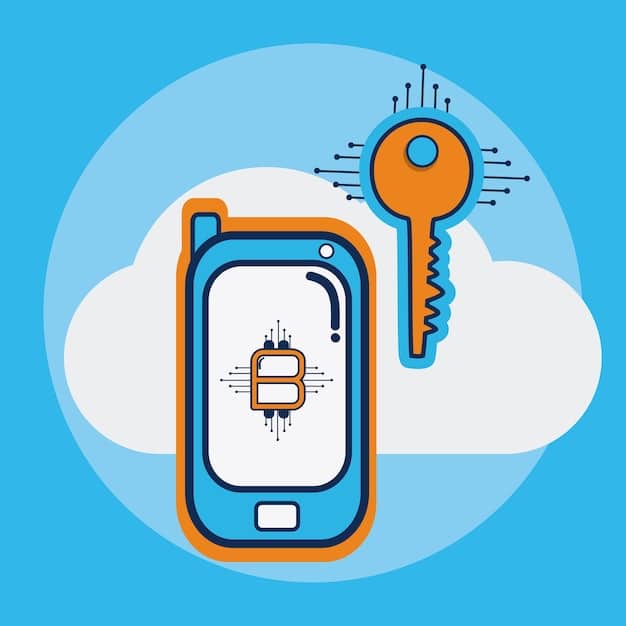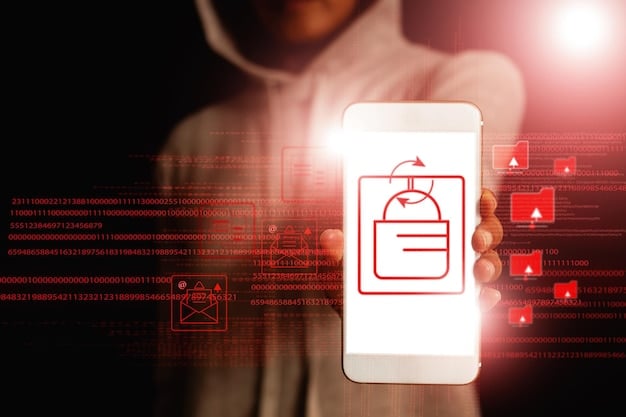Encrypted Messaging Apps: Top Privacy Choices for 2025

Encrypted messaging apps will continue to evolve in 2025, with Signal, WhatsApp, and Telegram leading the pack, though users should consider features like end-to-end encryption, open-source code, and independent security audits to ensure the best privacy for their needs, as vulnerabilities can change rapidly.
In the ever-evolving landscape of digital communication, privacy remains a paramount concern. As we look ahead to 2025, choosing the right encrypted messaging apps becomes crucial for safeguarding your personal information.
Encrypted Messaging Apps: Understanding the Basics
Before diving into specific app recommendations, it’s essential to understand the fundamental principles behind encrypted messaging. Encryption protects your messages from being intercepted and read by third parties, ensuring that only you and the recipient can access the content.
End-to-end encryption is a key feature to look for. Let’s explore why it’s so important.
The Importance of End-to-End Encryption
End-to-end encryption ensures that messages are encrypted on the sender’s device and can only be decrypted on the recipient’s device. This prevents eavesdropping by anyone in between, including the messaging service provider itself.
Consider the following aspects within this encryption:
- Data Security: Secures sensitive information from unauthorized access.
- Privacy Protection: Guarantees that only intended parties can read the messages.
- Regulatory Compliance: Meets privacy standards and legal requirements.

Furthermore, the reliability of the encryption protocol used by the app is paramount. Strong, well-vetted protocols provide a higher level of assurance that your communications remain private.
In summary, understanding the essentials of encrypted messaging is the first step to securing your privacy in 2025. Ensuring that your chosen app uses end-to-end encryption and a robust encryption protocol is crucial for maintaining confidentiality.
Top Encrypted Messaging Apps for 2025
With a solid grasp of the basics, let’s explore some of the leading encrypted messaging apps expected to offer the best privacy features in 2025. These apps have consistently demonstrated a commitment to user privacy and security.
Each has its strengths; it’s about finding the best fit. Consider these options:
Signal
Signal is widely regarded as one of the most secure messaging apps available. It is open-source, meaning its code is publicly available for review, and it uses end-to-end encryption by default for all communications.
Consider these advantages:
- Open-Source Code: Allows for transparency and community audits.
- End-to-End Encryption: Provides secure communication by default.
- Minimal Data Collection: Collects very little metadata from users.
WhatsApp, with its massive user base, also offers end-to-end encryption. However, its privacy practices have faced scrutiny due to its ownership by Facebook (Meta). Despite this, WhatsApp remains a popular choice for many users.
Telegram
Telegram provides end-to-end encryption through its “Secret Chat” feature. While the default chats are not end-to-end encrypted, Telegram offers a range of features and a large user base, making it a viable option for those seeking encrypted communication.
Overall, the best encrypted messaging app for you depends on your specific needs and priorities. Signal stands out as a top choice for those prioritizing maximum security and privacy, while WhatsApp and Telegram offer a balance of security and convenience.
Evaluating Privacy Features: What to Look For
Selecting an encrypted messaging app isn’t solely about choosing a popular name; it involves a closer look at the specific privacy features each app offers. Understanding these features can help you make a more informed decision.
It’s not just about encryption. Consider these features when making your choice:
End-to-End Encryption
As previously discussed, end-to-end encryption is paramount. Verify that the app uses a strong encryption protocol and that it is enabled by default.
Open-Source Code and Audits
Apps with open-source code allow for independent security audits, which can help identify and address vulnerabilities. Regular audits by reputable security firms are a good sign.
Data Collection and Metadata
Pay attention to the amount of data the app collects and how it uses your metadata. Apps that minimize data collection generally offer better privacy.
Two-Factor Authentication
Enabling two-factor authentication adds an extra layer of security to your account, preventing unauthorized access even if your password is compromised.

Evaluating these privacy features will help you choose an app that aligns with your privacy requirements in 2025. Take the time to compare the features offered by different apps and consider which ones are most important to you.
The Future of Encrypted Messaging: Trends to Watch
The world of encrypted messaging is continuously evolving, with new technologies and trends shaping the landscape. Keeping an eye on these developments can help you stay ahead of the curve and make informed choices.
What’s next? These trends could influence your app choice:
Quantum-Resistant Encryption
As quantum computing advances, the need for encryption methods that can withstand quantum attacks becomes increasingly important. Some messaging apps may begin to implement quantum-resistant encryption protocols.
Decentralized Messaging
Decentralized messaging platforms aim to eliminate central servers, making it more difficult for governments or corporations to censor or monitor communications. These platforms could gain traction in the coming years.
Integration with Web3 Technologies
Some encrypted messaging apps may integrate with Web3 technologies, such as blockchain and decentralized identity solutions, to provide enhanced privacy and security features.
Staying informed about these trends will allow you to select encrypted messaging apps that are well-positioned to protect your privacy in the long term. The future of encrypted messaging is likely to bring even more sophisticated security measures and privacy-enhancing technologies.
Practical Tips for Maximizing Your Privacy
Beyond choosing the right app, there are several practical steps you can take to maximize your privacy when using encrypted messaging. These tips can help you maintain control over your personal information.
These tips can help you take ownership of your privacy:
Use Strong Passwords
Always use strong, unique passwords for your messaging accounts. Avoid using the same password for multiple services.
Enable Two-Factor Authentication
As mentioned earlier, enabling two-factor authentication adds an extra layer of security to your account.
Be Cautious About Sharing Personal Information
Avoid sharing sensitive personal information over messaging apps unless absolutely necessary. Be mindful of who you are communicating with and what information you are sharing.
Regularly Review App Permissions
Review the permissions granted to your messaging apps and revoke any unnecessary permissions. This can help limit the amount of data the app can access.
By following these practical tips, you can significantly enhance your privacy when using encrypted messaging apps. Remember that maintaining privacy is an ongoing process that requires vigilance and proactivity.
Staying Informed: Resources and Updates
The world of digital privacy is constantly changing, so it’s essential to stay informed about the latest developments and best practices. Numerous resources can help you stay up-to-date.
Keep your knowledge fresh:
- Privacy Foundations: Provides resources of privacy.
- Tech Blogs: Follow tech blogs that offer insights into privacy-focused messaging apps.
- Security Experts: Listen to security and privacy experts.
Staying informed and continually reassessing your privacy practices will help you navigate the evolving landscape of encrypted messaging and protect your personal information effectively.
| Key Element | Brief Description |
|---|---|
| 🔒 End-to-End Encryption | Ensures only you and the recipient can read messages. |
| 👁️ Open-Source Code | Enables independent security audits and transparency. |
| 🛡️ Two-Factor Authentication | Adds extra security to prevent unauthorized access. |
| ⚙️ Minimal Data Collection | Reduces the risk of your data being misused or exposed. |
FAQ
▼
A secure encrypted messaging app uses end-to-end encryption by default, has open-source code for transparency, and minimizes data collection. Regular security audits are essential, ensuring no vulnerabilities.
▼
WhatsApp offers end-to-end encryption, but its data policies raise concerns. User data is shared with Facebook, influencing other services. Evaluate your comfort with this data-sharing practice.
▼
Signal uses open-source code, end-to-end encryption by default, collects minimal data. These features make it one of the most private and secure messaging apps available today for broad audiences.
▼
Look for end-to-end encryption settings (ensure it’s enabled), two-factor authentication, options to control data usage, permission controls, disappearing messages, and privacy settings controlling your discoverability.
▼
New threats include metadata analysis, quantum computing attacks (in the future), sophisticated phishing attempts, and vulnerabilities in encryption protocols. Staying informed is essential to mitigate potential risks.
Conclusion
As we navigate the digital age leading into 2025, the importance of choosing the right encrypted messaging apps cannot be overstated. By prioritizing apps with robust end-to-end encryption, open-source code, and minimal data collection, and by staying informed about emerging threats and privacy-enhancing technologies, you can take control of your digital privacy and communicate with confidence.





